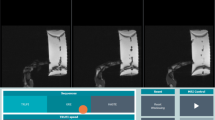Abstract
Purpose
The interaction with interventional imaging systems within a sterile environment is a challenging task for physicians. Direct physician–machine interaction during an intervention is rather limited because of sterility and workspace restrictions.
Methods
We present a gesture-controlled projection display that enables a direct and natural physician–machine interaction during computed tomography (CT)-based interventions. Therefore, a graphical user interface is projected on a radiation shield located in front of the physician. Hand gestures in front of this display are captured and classified using a leap motion controller. We propose a gesture set to control basic functions of intervention software such as gestures for 2D image exploration, 3D object manipulation and selection. Our methods were evaluated in a clinically oriented user study with 12 participants.
Results
The results of the performed user study confirm that the display and the underlying interaction concept are accepted by clinical users. The recognition of the gestures is robust, although there is potential for improvements. The gesture training times are less than 10 min, but vary heavily between the participants of the study. The developed gestures are connected logically to the intervention software and intuitive to use.
Conclusions
The proposed gesture-controlled projection display counters current thinking, namely it gives the radiologist complete control of the intervention software. It opens new possibilities for direct physician–machine interaction during CT-based interventions and is well suited to become an integral part of future interventional suites.






Similar content being viewed by others
References
Rutala WA, White MS, Gergen MF, Weber DJ (2006) Bacterial contamination of keyboards: efficacy and functional impact of disinfectants. Infect Control Hosp Epidemiol Off J Soc Hosp Epidemiol Am 27(4):372–377
Schultz M, Gill J, Zubairi S, Huber R, Gordin F (2003) Bacterial contamination of computer keyboards in a teaching hospital. Infect Control Hosp Epidemiol Off J Soc Hosp Epidemiol Am 24(4):302–303
Hübler A, Hansen C, Beuing O, Skalej M, Preim B (2014) Workflow analysis for interventional neuroradiology using frequent pattern mining. In: 13. Jahrestagung der Deutschen Gesellschaft für Computer- und Roboterassistierte Chirurgie (CURAC), pp 29–31
Preim B, Botha C (2014) Chapter 5—Human-computer interaction for medical visualization. In: Preim B, Botha C (eds) Visual computing for medicine, 2nd edn. Morgan Kaufmann, Boston, pp 177–225
Wachs JP, Stern HI, Edan Y, Gillam M, Handler J, Feied C, Smith M (2008) A gesture-based tool for sterile browsing of radiology images. J Am Med Inform Assoc JAMIA 15(3):321–323
Ritter F, Hansen C, Wilkens K, Köhn A, Peitgen HO (2009) User interfaces for direct interaction with 3d planning data in the operation room. Journal of i-com (Zeitschrift für interaktive und kooperative Medien) 8(1):24–31
Wigdor D, Wixon D (2011) Brave NUI world: designing natural user interfaces for touch and gesture, 1st. Morgan Kaufmann, San Francisco
Baer A, Hübler A, Saalfeld P, Cunningham D, Preim B (2014) A comparative user study of a 2D and an autostereoscopic 3D display for a tympanoplastic surgery. In: Proceedings of Eurographics workshop on visual computing for biology and medicine (EG VCBM), pp 181–190
Soutschek S, Penne J, Hornegger J, Kornhuber J (2008) 3-D gesture-based scene navigation in medical imaging applications using time-of-flight cameras. In: Computer vision and pattern recognition workshops, 2008. CVPRW ‘08. IEEE computer society conference on, pp 1–6
Kollorz E, Penne J, Hornegger J, Barke A (2008) Gesture recognition with a time-of-flight camera. Int J Intell Syst Technol Appl 5(3):334–343
Ebert LC, Hatch G, Ampanozi G, Thali MJ, Ross S (2012) You can’t touch this: touch-free navigation through radiological images. Surg Innov 19(3):301–307
Gallo L, Placitelli AP, Ciampi M (2011) Controller-free exploration of medical image data: experiencing the Kinect. In: Computer-based medical systems (CBMS), 2011 24th international symposium on, pp 1–6
Hötker AM, Pitton MB, Mildenberger P, Düber C (2013) Speech and motion control for interventional radiology: requirements and feasibility. Int J Comput Assist Radiol Surg 8(6):997–1002
Jacob MG, Wachs JP, Packer RA (2013) Hand-gesture-based sterile interface for the operating room using contextual cues for the navigation of radiological images. J Am Med Inform Assoc JAMIA 20(e1):e183–e186
Bizzotto N, Costanzo A, Bizzotto L, Regis D, Sandri A, Magnan B (2014) Leap motion gesture control with osirix in the operating room to control imaging: first experiences during live surgery. Surg Innov 21(6):655–656
Mauser S, Burgert O (2014) Touch-free, gesture-based control of medical devices and software based on the leap motion controller. Stud Health Technol Inform 196:265–270
Rosa GM, Elizondo ML (2014) Use of a gesture user interface as a touchless image navigation system in dental surgery: Case series report. Imaging Sci Dent 44(2):155–160
Weichert F, Bachmann D, Rudak B, Fisseler D (2013) Analysis of the accuracy and robustness of the leap motion controller. Sensors (Basel, Switzerland) 13(5):6380–6393
Guna J, Jakus G, Pogačnik M, Tomažič S, Sodnik J (2014) An analysis of the precision and reliability of the leap motion sensor and its suitability for static and dynamic tracking. Sensors (Basel, Switzerland) 14(2):3702–3720
Nielsen M, Störring M, Moeslund TB, Granum E (2004) A procedure for developing intuitive and ergonomic gesture interfaces for HCI. In: Goos G, Hartmanis J, van Leeuwen J, Camurri A, Volpe G (eds) Gesture-based communication in human-computer interaction, vol 2915. Springer, Berlin, pp 409–420
Ericsson KA, Simon HA (1984) Protocol analysis. Verbal reports as data. MIT Press, Cambridge
Prümper J (1997) Der Benutzungsfragebogen ISONORM 9241/10: Ergebnisse zur Reliabilität und Validität. In: Software-Ergonomie’97. Springer, pp 253–262
Acknowledgments
The work of this paper is partly funded by the Federal Ministry of Education and Research within the Forschungscampus STIMULATE under Grant number “13GW0095A.”
Author information
Authors and Affiliations
Corresponding author
Rights and permissions
About this article
Cite this article
Mewes, A., Saalfeld, P., Riabikin, O. et al. A gesture-controlled projection display for CT-guided interventions. Int J CARS 11, 157–164 (2016). https://doi.org/10.1007/s11548-015-1215-0
Received:
Accepted:
Published:
Issue Date:
DOI: https://doi.org/10.1007/s11548-015-1215-0




